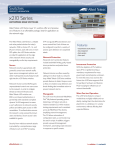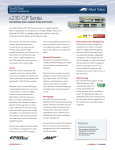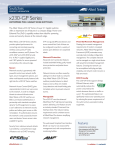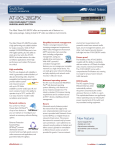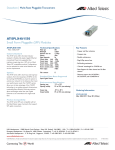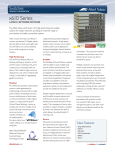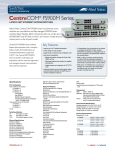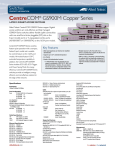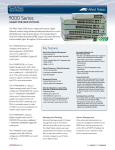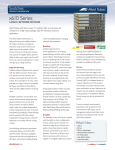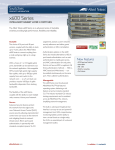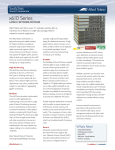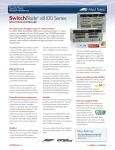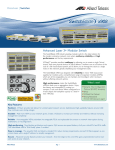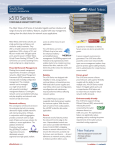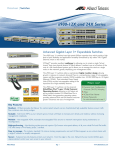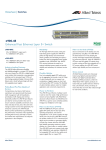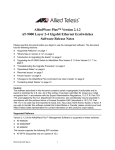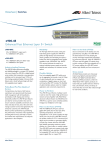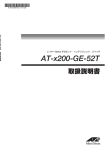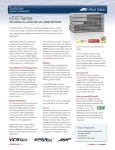Download Allied Telesis AT-x210-24GT
Transcript
Switches PRODUCT INFORMATION x210 Series ENTERPRISE EDGE SWITCHES Allied Telesis x210 Series Layer 2+ switches offer an impressive set of features in an affordable package, ideal for applications at the network edge. The Allied Telesis x210 Series is a reliable and value-packed solution for today’s networks. With a choice of 9-, 16- and 24-port versions, each with one or more SFP uplinks, the x210 Series switches are ideal for applications at the edge of the network where security and manageability are the key requirements. Secure Network security is guaranteed, with powerful control over network traffic types, secure management options, and other multi-layered security features built right into the x210 Series switches. Allied Telesis x210 switches use 802.1x port-based authentication, in partnership with standards-compliant dynamic VLAN assignment, to assess a user’s adherence to network security policies and either grant access or offer remediation. Tri-authentication ensures the network is only accessed by known users and devices. Secure access is also available for guests. Security from malicious network attacks is provided by a comprehensive range of features such as DHCP snooping, STP root guard, BPDU protection and access control lists. Each of these can be configured to perform a variety of actions upon detection of a suspected attack. Network Protection Advanced storm protection features include bandwidth limiting, policy-based storm protection and packet storm protection. Network storms are often caused by cabling errors that result in a network loop. Allied Telesis x210 Series switches provide features to detect loops as soon as they are created. Loop detection and thrash limiting take immediate action to prevent network storms. Manageable The x210 runs the advanced AlliedWare Plus™ fully featured operating system, delivering a rich feature set and an industry-standard CLI. Which, combined with a powerful web-based GUI, reduces training requirements and is consistent across all AlliedWare Plus devices, simplifying network management. Powerful Network Management Meeting the increased management requirements of modern converged networks, Allied Telesis Management Framework (AMF) automates many everyday tasks including configuration management. The complete network can be managed as a single virtual device with powerful centralized management features. Investment Protection With the depletion of IPv4 address space, IPv6 is rapidly becoming a mandatory requirement for many government and enterprise customers. To meet this need, now and into the future, the x210 Series supports IPv6 forwarding in hardware and features MLD snooping for efficient use of network bandwidth. Silent Fan-less Operation The x210 Series features compact models that are highly reliable and run silently, making them the ideal choice for placement on a desktop or in a dusty environment, without affecting their expected lifetime. Features »»Comprehensive security features »» Easy management with AMF »» Silent operation »» Future-proof »» EPSRTM compatible alliedtelesis.com x210 Series | Enterprise Edge Switches Key Features Allied Telesis Management Framework (AMF) »»Allied Telesis Management Framework (AMF) is a sophisticated suite of management tools that provide a simplified approach to network management. Common tasks are automated or made so simple that the every-day running of a network can be achieved without the need for highly-trained, and expensive, network engineers. Powerful features like centralized management, auto-backup, auto-upgrade, autoprovisioning and auto-recovery enable plug-and-play networking and zero-touch management. Easy to Manage »»The AlliedWare Plus operating system incorporates an industry standard CLI, facilitating intuitive manageability. »»With three distinct modes, the CLI is very secure, and the use of SSHv2 encrypted and strongly authenticated remote login sessions ensures CLI access is not compromised. »»As a Layer 2+ switch, a static route can be added to allow a user in a different subnet to manage the switch. Storm Protection Advanced packet storm control features protect the network from broadcast storms: »» Bandwidth limiting minimizes the effects of the storm by reducing the amount of flooding traffic. »» Policy-based storm protection is more powerful than bandwidth limiting. It restricts storm damage to within the storming VLAN, and it provides the flexibility to define the traffic rate that creates a broadcast storm. The action the device should take when it detects a storm can be configured, such as disabling the port from the VLAN or shutting the port down. »» Packet storm protection allows limits to be set on the broadcast reception rate, multicast frames and destination lookup failures. In addition, separate limits can be set to specify when the device will discard each of the different packet types. Loop Protection »»Thrash limiting, also known as Rapid MAC movement, detects and resolves network loops. It is highly user-configurable — from the rate of looping traffic 2 | x210 Series to the type of action the switch should take when it detects a loop. »»With thrash limiting, the switch only detects a loop when a storm has occurred, which can potentially cause disruption to the network. To avoid this, loop detection works in conjunction with thrash limiting to send special packets, called Loop Detection frames (LDF), that the switch listens for. If a port receives an LDF packet, one can choose to disable the port, disable the link, or send an SNMP trap. Spanning Tree Protocol (STP) Root Guard »» STP root guard designates which devices can assume the root bridge role in an STP network. This stops an undesirable device from taking over this role, where it could either compromise network performance or cause a security weakness. Bridge Protocol Data Unit (BPDU) Protection »» BPDU protection adds extra security to STP. It protects the spanning tree configuration by preventing malicious DoS attacks caused by spoofed BPDUs. If a BPDU packet is received on a protected port, the BPDU protection feature disables the port and alerts the network manager. Access Control Lists (ACLs) »»The x210 Series features industry-standard access control functionality through ACLs. ACLs filter network traffic to control whether packets are forwarded or blocked at the port interface. This provides a powerful network security mechanism to select the types of traffic to be analyzed, forwarded, or influenced in some way. An example of this would be to provide traffic flow control. Tri-authentication »»Authentication options on the x210 Series also include alternatives to 802.1x port-based authentication, such as web authentication, to enable guest access and MAC authentication for end points that do not have an 802.1x supplicant. All three authentication methods—802.1x, MAC-based and Web-based—can be enabled simultaneously on the same port, resulting in tri-authentication. Dynamic Host Configuration Protocol (DHCP) Snooping »» DHCP servers allocate IP addresses to clients, and the switch keeps a record of addresses issued on each port. IP source guard checks this against the DHCP snooping database to ensure only clients with specific IP and/or MAC addresses can access the network. Combining DHCP snooping with other features, like dynamic ARP inspection, increases security in Layer 2 switched environments. This also provides a traceable history, which meets the growing legal requirements placed on service providers. Strong Passwords »» Enforcing strong passwords for key networking equipment users allows network administrators to increase security, and ensure a robust and reliable infrastructure. EPSRingTM (Ethernet Protection Switched Ring) »» EPSRing allows several x210 switches to join a protected ring capable of recovery within as little as 50ms. This feature is perfect for high availability in enterprise networks. Link Aggregation »» Link aggregation allows a number of individual switch ports to be combined, forming a single logical connection of higher bandwidth. This provides higher performance link, and also provides redundancy for a more reliable and robust network. Voice VLAN »»Voice VLAN automatically separates voice and data traffic into two different VLANs. This automatic separation places delay-sensitive traffic into a voice dedicated VLAN, simplifying QoS configuration. Find Me »» In busy server rooms comprised of a large number of equipment racks, it can be quite a job finding the correct switch quickly among many similar units. The “Find Me” feature is a simple visual way to quickly identify the desired physical switch for maintenance or other purposes, by causing its LEDs to flash in a specified pattern. x210 Series | Enterprise Edge Switches Key Solutions x2 10 Network Convergence The convergence of network services in the Enterprise has led to increasing demand for highly available networks with minimal downtime. Diagram 1 shows x210-24GT switches with high performance EPSR connectivity to the SwitchBlade® x8112 core chassis. This topology provides recovery in as little as 50ms, if required. Management of the network is simplified as all x-series switches run the advanced AlliedWare Plus operating system, with an industrystandard CLI. -2 T 4G x2 10 -2 T 4G T 4G -2 10 x2 2 11 x8 SB Servers GT -9 10 x2 10 x6 T G -9 10 x2 x6 10 T 6G -1 10 x2 12 81 x SB Network Flexibility Flexible network deployment is facilitated by the smaller 9- and 16port x210 models, shown in diagram 2. Whisper quiet with a fanless design, they can be placed in work areas and on desks without disrupting staff. AMF provides an easy yet powerful solution for managing devices with plug and play simplicity. Network Attached Storage Servers x210 Series | 3 x210 Series | Enterprise Edge Switches Product Specifications PRODUCT 10/100/1000T (RJ-45) COPPER PORTS SFP AND 10/100/1000T COMBO PORTS 100/1000X SFP PORTS TOTAL PORTS SWITCHING FABRIC FORWARDING RATE 8 - 1 9 18 Gbps 13.4 Mpps AT-x210-9GT AT-x210-16GT 14 2 - 16 32 Gbps 23.8 Mpps AT-x210-24GT 20 4 - 24 48 Gbps 35.7 Mpps Physical Specifications PRODUCT WEIGHT HEIGHT WIDTH DEPTH MOUNTING AT-x210-9GT 38 mm (1.50 in) 263 mm (10.35 in) 179 mm (7.05 in) Desktop* AT-x210-16GT 44 mm (1.73 in) 341 mm (13.42 in) 210 mm (8.27 in) Desktop* 2.0 kg (4.41 lb) AT-x210-24GT 44 mm (1.73 in) 440 mm (17.32 in) 210 mm (8.27 in) Rack-mount 2.7 kg (5.95 lb) UNPACKAGED PACKAGED 1.4 kg (3.09 lb) * Rack-mount kit available Performance »» Up to 8K MAC addresses »»256 VLANs (4K VLAN IDs) »»128MB DDR SDRAM »» 64MB flash memory »» Packet Buffer memory: 512KB »» Supports 9kB jumbo frames »»Wirespeed forwarding Reliability »» Modular AlliedWare Plus operating system »» Full environmental monitoring of PSU internal temperature and internal voltages. SNMP traps alert network managers in case of any failure Flexibility and Compatibility »» SFP ports will support any combination of 10/100/1000T, 100X, 100FX, 100BX, 1000X, 1000SX, 1000LX, 1000ZX or 1000ZX CWDM SFPs Diagnostic Tools »» Find-me device locator »»Cable fault locator (TDR) »»Automatic link flap detection and port shutdown »» Ping polling for IPv4 and IPv6 »» Port mirroring »»TraceRoute for IPv4 and IPv6 IPv6 features »» Device management over IPv6 networks with SNMPv6, Telnetv6 and SSHv6 »» NTPv6 client and server Management »»Allied Telesis Management Framework (AMF) enables powerful centralized management and zerotouch device installation and recovery »»Console management port on the front panel for ease of access »» Eco-friendly mode allows ports and LEDs to be disabled to save power »»Web-based Graphical User Interface (GUI) »» Industry-standard CLI with context-sensitive help »» Powerful CLI scripting engine »»Comprehensive SNMP MIB support for standardsbased device management »» Built-in text editor 4 | x210 Series »» Event-based triggers allow user-defined scripts to be executed upon selected system events Quality of Service (QoS) »»4 priority queues with a hierarchy of high priority queues for real time traffic, and mixed scheduling, for each switch port »» Limit bandwidth per port or per traffic class down to 64kbps »»Wirespeed traffic classification with low latency essential for VoIP and real-time streaming media applications »» Policy-based QoS based on VLAN, port, MAC and general packet classifiers »» Policy-based storm protection »» Extensive remarking capabilities »»Taildrop for queue congestion control »» Strict priority, weighted round robin or mixed scheduling »» IP precedence and DiffServ marking based on layer 2, 3 and 4 headers Resiliency »»Control Plane Prioritization (CPP) ensures the CPU always has sufficient bandwidth to process network control traffic »» Dynamic link failover (host attach) »» EPSRing (Ethernet Protection Switched Rings) with enhanced recovery for extra resiliency »» Loop protection: loop detection and thrash limiting »» PVST+ compatibility mode »» RRP snooping »» STP root guard Security »»Access Control Lists (ACLs) based on layer 3 and 4 headers »»Configurable auth-fail and guest VLANs »»Authentication, Authorisation and Accounting (AAA) »» Bootloader can be password protected for device security »» BPDU protection »» DHCP snooping, IP source guard and Dynamic ARP Inspection (DAI) »» Dynamic VLAN assignment »» Network Access and Control (NAC) features manage endpoint security »» Port-based learn limits (intrusion detection) »» Private VLANs provide security and port isolation for multiple customers using the same VLAN »» Secure Copy (SCP) »» Strong password security and encryption »»Tri-authentication: MAC-based, web-based and IEEE 802.1x Environmental Specifications »»Operating temperature range: x210-9GT: 0°C to 50°C (32°F to 122°F) x210-9GT: 0°C to 45°C (32°F to 113°F) with AT-SPLX40 or AT-SPZX80 x210-16GT: 0°C to 40°C (32°F to 104°F) x210-16GT: 0°C to 35°C (32°F to 95°F) with AT-SPLX40 or AT-SPZX80 or AT-SPFX/2 or AT-SPFX/15 x210-24GT: 0°C to 40°C (32°F to 104°F) Derated by 1°C per 305 meters (1,000 ft) »» Storage temperature range: -25°C to 70°C (-13°F to 158°F) Operating relative humidity range: 5% to 90% non-condensing »» Storage relative humidity range: 5% to 95% non-condensing »»Operating altitude: 3,048 meters maximum (10,000 ft) Electrical Approvals and Compliances »» EMC: EN55022 class A, FCC class A, VCCI class A »» Immunity: EN55024, EN61000-3-levels 2 (Harmonics), and 3 (Flicker) – AC models only Safety »» Standards: UL60950-1, CAN/CSA-C22.2 No. 60950-1-03, EN60950-1, EN60825-1, AS/NZS 60950.1 »»Certifications: UL, cUL, UL-EU Restrictions on Hazardous Substances (RoHS) Compliance »» EU RoHS compliant »»China RoHS compliant Country of Origin »»China x210 Series | Enterprise Edge Switches Power and Noise Characteristics AVERAGE POWER CONSUMPTION MAX POWER CONSUMPTION AVERAGE HEAT DISSIPATION MAX HEAT DISSIPATION NOISE AT-x210-9GT PRODUCT 8.6W 12W 28.4 BTU/hr 41.7 BTU/hr Fan-less AT-x210-16GT 16W 19W 55.9 BTU/hr 64.5 BTU/hr Fan-less AT-x210-24GT 25W 28W 85.3 BTU/hr 94.8 BTU/hr Fan-less Latency (microseconds) PRODUCT PORT SPEED 10MBPS PORT SPEED 100MBPS PORT SPEED 1000MBPS 63.4µs 9.2µs 4.1µs AT-x210-9GT; AT-x210-16GT; AT-x210-24GT Standards and Protocols AlliedWare Plus Operating System Version 5.4.5 Authentication RFC 1321 MD5 Message-Digest algorithm RFC 1828 IP authentication using keyed MD5 Encryption FIPS 180-1 Secure Hash standard (SHA-1) FIPS 186 Digital signature standard (RSA) FIPS 46-3 Data Encryption Standard (DES and 3DES) Ethernet IEEE 802.1AXLink aggregation (static and LACP) IEEE 802.2 Logical Link Control (LLC) IEEE 802.3 Ethernet IEEE 802.3ab1000BASE-T IEEE 802.3adStatic and dynamic link aggregation IEEE 802.3u 100BASE-X IEEE 802.3x Flow control - full-duplex operation IEEE 802.3z 1000BASE-X IPv4 Standards RFC 791 Internet Protocol (IP) RFC 792 Internet Control Message Protocol (ICMP) RFC 826 Address Resolution Protocol (ARP) RFC 894 Standard for the transmission of IP datagrams over Ethernet networks RFC 919 Broadcasting Internet datagrams RFC 922 Broadcasting Internet datagrams in the presence of subnets RFC 932 Subnetwork addressing scheme RFC 950 Internet standard subnetting procedure RFC 1042 Standard for the transmission of IP datagrams over IEEE 802 networks RFC 1071 Computing the Internet checksum RFC 1122 Internet host requirements RFC 1191 Path MTU discovery RFC 1256 ICMP router discovery messages RFC 1518 An architecture for IP address allocation with CIDR RFC 1519 Classless Inter-Domain Routing (CIDR) RFC 1812 Requirements for IPv4 routers RFC 1918 IP addressing IPv6 Standards RFC 1981 Path MTU discovery for IPv6 RFC 2460 IPv6 specification RFC 2464 Transmission of IPv6 packets over Ethernet networks RFC 3484 Default address selection for IPv6 RFC 3596 DNS extensions to support IPv6 RFC 4007 IPv6 scoped address architecture RFC 4193 Unique local IPv6 unicast addresses RFC 4291 IPv6 addressing architecture RFC 4443 Internet Control Message Protocol (ICMPv6) RFC 4861 Neighbor discovery for IPv6 RFC 4862 IPv6 Stateless Address Auto-Configuration (SLAAC) RFC 5014 RFC 5095 IPv6 socket API for source address selection Deprecation of type 0 routing headers in IPv6 Management AMF MIB and SNMP traps AT Enterprise MIB SNMPv1, v2c and v3 IEEE 802.1ABLink Layer Discovery Protocol (LLDP) RFC 1155 Structure and identification of management information for TCP/IP-based Internets RFC 1157 Simple Network Management Protocol (SNMP) RFC 1212 Concise MIB definitions RFC 1213 MIB for network management of TCP/IP-based Internets: MIB-II RFC 1215 Convention for defining traps for use with the SNMP RFC 1227 SNMP MUX protocol and MIB RFC 1239 Standard MIB RFC 2011 SNMPv2 MIB for IP using SMIv2 RFC 2012 SNMPv2 MIB for TCP using SMIv2 RFC 2013 SNMPv2 MIB for UDP using SMIv2 RFC 2096 IP forwarding table MIB RFC 2578 Structure of Management Information v2 (SMIv2) RFC 2579 Textual conventions for SMIv2 RFC 2580 Conformance statements for SMIv2 RFC 2674 Definitions of managed objects for bridges with traffic classes, multicast filtering and VLAN extensions RFC 2741 Agent extensibility (AgentX) protocol RFC 2819 RMON MIB (groups 1,2,3 and 9) RFC 2863 Interfaces group MIB RFC 3164 Syslog protocol RFC 3176 sFlow: a method for monitoring traffic in switched and routed networks RFC 3411 An architecture for describing SNMP management frameworks RFC 3412 Message processing and dispatching for the SNMP RFC 3413 SNMP applications RFC 3414 User-based Security Model (USM) for SNMPv3 RFC 3415 View-based Access Control Model (VACM) for SNMP RFC 3416 Version 2 of the protocol operations for the SNMP RFC 3417 Transport mappings for the SNMP RFC 3418 MIB for SNMP RFC 3635 Definitions of managed objects for the Ethernet- like interface types RFC 3636 IEEE 802.3 MAU MIB RFC 4188 Definitions of managed objects for bridges RFC 4318 Definitions of managed objects for bridges with RSTP RFC 4560 Definitions of managed objects for remote ping, traceroute and lookup operations Multicast Support IGMP query solicitation IGMP snooping (IGMPv1, v2 and v3) IGMP snooping fast-leave MLD snooping (MLDv1 and v2) Quality of Service (QoS) IEEE 802.1p Priority tagging RFC 2211 Specification of the controlled-load network element service RFC 2474 DiffServ precedence for four queues/port RFC 2475 DiffServ architecture RFC 2597 DiffServ Assured Forwarding (AF) RFC 2697 A single-rate three-color marker RFC 2698 A two-rate three-color marker RFC 3246 DiffServ Expedited Forwarding (EF) Resiliency IEEE 802.1D MAC bridges IEEE 802.1s Multiple Spanning Tree Protocol (MSTP) IEEE 802.1w Rapid Spanning Tree Protocol (RSTP) Security SSH remote login SSLv2 and SSLv3 TACACS+ accounting and authentication IEEE 802.1X authentication protocols (TLS, TTLS, PEAP and MD5) IEEE 802.1X multi-supplicant authentication IEEE 802.1X port-based network access control RFC 2246 TLS protocol v1.0 RFC 2818 HTTP over TLS (“HTTPS”) RFC 2865 RADIUS RFC 2866 RADIUS accounting RFC 3280 Internet X.509 PKI Certificate and Certificate Revocation List (CRL) profile RFC 3546 Transport Layer Security (TLS) extensions RFC 3748 PPP Extensible Authentication Protocol (EAP) RFC 4251 Secure Shell (SSHv2) protocol architecture RFC 4252 Secure Shell (SSHv2) authentication protocol RFC 4253 Secure Shell (SSHv2) transport layer protocol RFC 4254 Secure Shell (SSHv2) connection protocol Services RFC 854 RFC 855 RFC 857 RFC 858 RFC 1091 RFC 1350 RFC 1985 RFC 2049 RFC 2131 RFC 2132 RFC 2554 RFC 2616 RFC 2821 RFC 2822 RFC 4330 RFC 5905 Telnet protocol specification Telnet option specifications Telnet echo option Telnet suppress go ahead option Telnet terminal-type option Trivial File Transfer Protocol (TFTP) SMTP service extension MIME DHCPv4 (server, relay and client) DHCP options and BootP vendor extensions SMTP service extension for authentication Hypertext Transfer Protocol - HTTP/1.1 Simple Mail Transfer Protocol (SMTP) Internet message format Simple Network Time Protocol (SNTP) version 4 Network Time Protocol (NTP) version 4 VLAN Support IEEE 802.1Q Virtual LAN (VLAN) bridges IEEE 802.1v VLAN classification by protocol and port IEEE 802.3acVLAN tagging Voice over IP LLDP-MEDANSI/TIA-1057 Voice VLAN x210 Series | 5 x210 Series | Enterprise Edge Switches Ordering Information AT-x210-9GT-xx L2+ switch with 8 x 10/100/1000T ports and one SFP port AT-RKMT-J05 Rack mount kit for x210-9GT AT-x210-16GT-xx L2+ switch with 14 x 10/100/1000T ports and 2 combo ports (SFP and 10/100/1000T) (Rack-mount kit included) AT-x210-24GT-xx L2+ switch with 20 x 10/100/1000T ports and 4 combo ports (SFP and 10/100/1000T) SFP Modules AT-SPFX/2* 100FX multi-mode 1310 nm fiber up to 2 km AT-SPFX/15* 100FX single-mode 1310 nm fiber up to 15 km AT-SPFXBD-LC-13 100BX Bi-Di (1310 nm Tx, 1550 nm Rx) fiber up to 10 km AT-SPFXBD-LC-15 100BX Bi-Di (1550 nm Tx, 1310 nm Rx) fiber up to 10 km AT-SPTX 1000T 100 m copper AT-SPSX 1000SX GbE multi-mode 850 nm fiber up to 550 m AT-SPSX/I 1000SX GbE multi-mode 850 nm fiber up to 550 m industrial temperature AT-SPEX 1000X GbE multi-mode 1310 nm fiber up to 2 km AT-SPLX10 1000LX GbE single-mode 1310 nm fiber up to 10 km AT-SPLXI0/1 1000LX GbE single-mode 1310 nm fiber up to 10 km industrial temperature AT-SPBDI0-13 1000LX GbE Bi-Di (1310 nm Tx, 1490 nm Rx) fiber up to 10 km AT-SPBDI0-14 1000LX GbE Bi-Di (1490 nm Tx, 1310 nm Rx) fiber up to 10 km AT-SPLX40 1000LX GbE single-mode 1310 nm fiber up to 40 km AT-SPZX80 1000ZX GbE single-mode 1550 nm fiber up to 80 km Where xx = 10 for US power cord 20 for no power cord 30 for UK power cord 40 for Australian power cord 50 for European power cord *The AT-SPFX/2 and AT-SPFX/15 are not supported in the x210-9GT North America Headquarters | 19800 North Creek Parkway | Suite 100 | Bothell | WA 98011 | USA | T: +1 800 424 4284 | F: +1 425 481 3895 Asia-Pacific Headquarters | 11 Tai Seng Link | Singapore | 534182 | T: +65 6383 3832 | F: +65 6383 3830 EMEA & CSA Operations | Incheonweg 7 | 1437 EK Rozenburg | The Netherlands | T: +31 20 7950020 | F: +31 20 7950021 alliedtelesis.com © 2015 Allied Telesis, Inc. All rights reserved. Information in this document is subject to change without notice. All company names, logos, and product designs that are trademarks or registered trademarks are the property of their respective owners. 617-000479 Rev K






